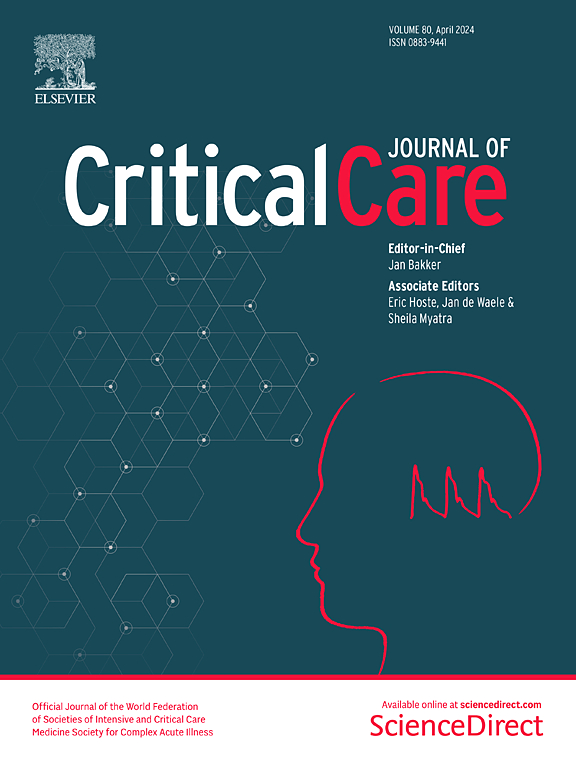临床结果和近红外光谱监测循环休克的膝关节区域外周组织氧饱和度:一项前瞻性观察队列研究
IF 8.8
1区 医学
Q1 CRITICAL CARE MEDICINE
引用次数: 0
摘要
在循环性休克中,组织灌注不足会导致不良后果。我们假设用近红外光谱(NIRS)测量外周组织氧饱和度(StO2)可以提供一种非侵入性的方法来评估组织灌注不足和预测即将发生的器官功能障碍和死亡率。assessment - shock是一项前瞻性观察性研究,纳入了2019年4月至2023年5月在3个重症监护病房(ICU)的循环性休克患者。入ICU后24 h内符合循环性休克标准的成年患者为合格患者。患者接受连续48小时的膝关节区域StO2 (INVOS™)监测。为了表达组织灌注不足的负担,我们计算平均StO2和低于预定义StO2阈值的区域。主要终点是顺序器官衰竭评估(SOFA)评分的变化,从入组到第7天或ICU出院,SOFA评分分为改善或无改善。7天内死亡被视为SOFA无改善。次要结果包括90天死亡率。我们纳入了256例患者。由于COVID-19大流行等多种原因,患者样本不是连续的。sofa改善者(n = 171) 48小时平均StO2中位数为68.3%(四分位数间距[IQR] 57.5-74.1),非改善者(n = 85)为63.5% (IQR 52.7-70.8, p = 0.020), 90天存活者为68.7% (IQR 58.2-74.5),非存活者为60.9% (IQR 49.5-67.1, p < 0.001)。在sofa改善者和非改善者之间,低于预定义StO2阈值的区域没有统计学上的显著差异,但在90天的非幸存者中,所有区域都更大。90天死亡率为27.0% (n = 69)。在多变量分析中,48小时平均StO2与90天死亡率相关(优势比[OR] 0.97, 95%可信区间[CI 95%] 0.94-1.00, p = 0.047),但与SOFA变化无关。然而,在多变量分析中,排除48小时登记期间死亡的患者(n = 29)最后6小时的StO2登记后,与死亡率的关联不再显著(OR 0.97, CI 95% 0.94-1.00, p = 0.062)。低外周StO2与循环休克危重患者90天死亡率相关,但与持续或恶化的器官功能障碍无关。近红外光谱(NIRS)有望作为循环休克中组织灌注的无创监测。试验注册:ClinicalTrials.gov标识符:NCT03814564,注册于2019年1月15日。本文章由计算机程序翻译,如有差异,请以英文原文为准。
Clinical outcomes and peripheral tissue oxygen saturation monitoring of the knee region by near-infrared spectroscopy in circulatory shock: a prospective observational cohort study
In circulatory shock, tissue hypoperfusion leads to adverse outcomes. We hypothesized that peripheral tissue oxygen saturation (StO2), measured with near-infrared spectroscopy (NIRS), could provide a non-invasive method for assessing tissue hypoperfusion and predicting pending organ dysfunction and mortality. ASSESS-SHOCK was a prospective, observational study enrolling circulatory shock patients from April 2019 to May 2023 in three intensive care units (ICU). Adult patients fulfilling the criteria for circulatory shock within 24 h of ICU admission were eligible. Patients underwent continuous 48 h StO2 (INVOS™) monitoring of the knee region. To express the burden of tissue hypoperfusion we calculated mean StO2 and areas below predefined StO2 thresholds. The primary outcome, change in Sequential Organ Failure Assessment (SOFA) score, was dichotomized to improvement or non-improvement in SOFA score from enrollment to day 7 or ICU discharge. Death within 7 days was considered as SOFA non-improvement. 90-day mortality was among the secondary outcomes. We included 256 patients. Due to several reasons, including the COVID-19 pandemic, the patient sample was not consecutive. The median of 48-h mean StO2 was 68.3% (interquartile range [IQR] 57.5–74.1) in SOFA-improvers (n = 171), compared to 63.5% (IQR 52.7–70.8, p = 0.020) in non-improvers (n = 85), and 68.7% (IQR 58.2–74.5) in 90-day survivors, versus 60.9% (IQR 49.5–67.1, p < 0.001) in non-survivors. There were no statistically significant differences in the areas below predefined StO2 thresholds between the SOFA-improvers and non-improvers but all the areas were larger in 90-day non-survivors. The 90-day mortality was 27.0% (n = 69). In multivariable analyses 48-h mean StO2 was associated with 90-day mortality (Odds ratio [OR] 0.97, 95% confidence interval [CI 95%] 0.94–1.00, p = 0.047) but not with SOFA change. The association with mortality was, however, no longer significant in multivariable analyses after exclusion of the last 6 hours of StO2 registration in the patients (n = 29) who died during the 48 h registration (OR 0.97, CI 95% 0.94–1.00, p = 0.062). Lower peripheral StO2 was associated with 90-day mortality in critically ill patients with circulatory shock but not with persisting or worsening organ dysfunction. NIRS shows promise as a non-invasive monitor of tissue perfusion in circulatory shock. Trial registration: ClinicalTrials.gov Identifier: NCT03814564, registered 15 January 2019.
求助全文
通过发布文献求助,成功后即可免费获取论文全文。
去求助
来源期刊

Critical Care
医学-危重病医学
CiteScore
20.60
自引率
3.30%
发文量
348
审稿时长
1.5 months
期刊介绍:
Critical Care is an esteemed international medical journal that undergoes a rigorous peer-review process to maintain its high quality standards. Its primary objective is to enhance the healthcare services offered to critically ill patients. To achieve this, the journal focuses on gathering, exchanging, disseminating, and endorsing evidence-based information that is highly relevant to intensivists. By doing so, Critical Care seeks to provide a thorough and inclusive examination of the intensive care field.
 求助内容:
求助内容: 应助结果提醒方式:
应助结果提醒方式:


